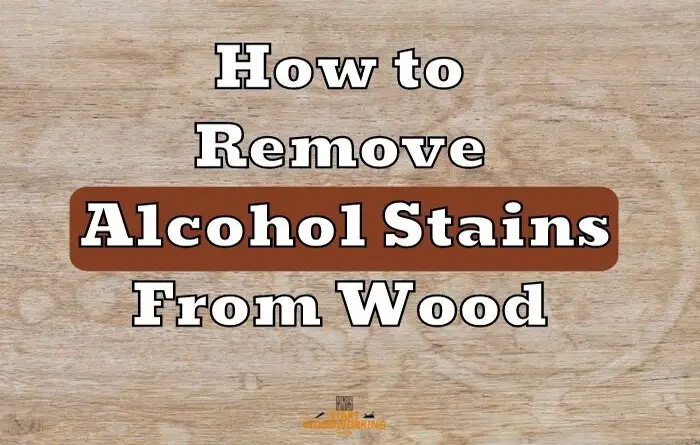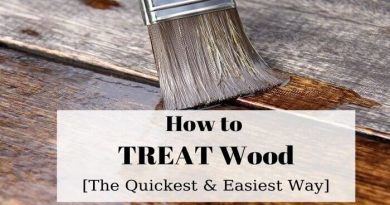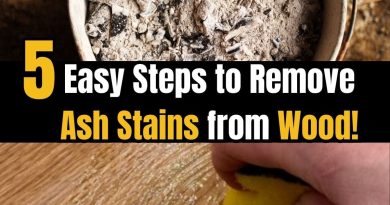Removing Alcohol Stains from Wood: 5 Best Methods That Work!
So if you have mistakenly used or spilled alcohol on a wooden surface, and some white spots do not want to go away, you can follow this tutorial where we show you how to remove alcohol stains from wood.
What You’ll Need:
- Baking soda
- Water
- Soft cloth
- Toothbrush or paintbrush
Steps to do:
1. In a small bowl, mix baking soda and water to form a spreadable paste. The consistency should be like toothpaste.
2. Using a soft cloth or old toothbrush, gently apply the baking soda paste directly onto the alcohol stain.
3. Let the paste sit for 5-10 minutes in the wood area to allow it to draw out the alcohol stain.
4. Gently scrub the paste into the wood using a soft bristle toothbrush or paintbrush. Rub following the direction of the wood grain.
5. Wipe away the baking soda paste with a clean damp cloth. Make sure to remove all the paste residue.
6. Dry the wood surface completely with a soft towel. Inspect to see if the alcohol stain has lightened or disappeared.
7. For stubborn stains, repeat the process, letting the baking soda paste sit for longer. It may take several applications.
8. Once the wood is alcohol stain-free, apply furniture oil or polish to condition and restore luster.
Method 1: Using Cooking Oil
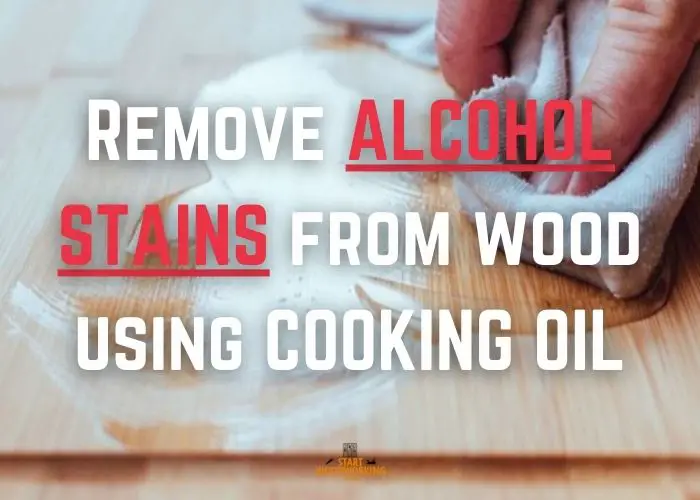
It is important to treat the alcohol stain immediately, the greater the chance that you will clear the stain.
What You’ll Need:
- Cooking oil
- Kitchen paper or clean cloth
- Damp cloth
- Dry cloth
- Paste or liquid wax (optional)
Step 1: Prepare the surface
First, I make sure the stained wood surface is cleared of any objects, decor, or debris that could get in the way. This gives me full access to the stain.
I select a high-quality cooking oil like olive, avocado or coconut oil. These contain fatty acids that help break down the alcohol stain.
Step 2: Apply a small amount of oil
I pour a teaspoon of a light cooking oil like canola or vegetable oil onto a clean, soft lint-free cloth. Using light pressure, I gently rub the oil over the entire alcohol stain area to saturate the wood grain.
Step 3: Let it soak for 2-3 minutes
I let the cooking oil sit for a few minutes so it can penetrate into the wood grain and start breaking down the alcohol residue. I may apply a thin second coat of oil to keep it wet.
Step 4: Wipe in circular motions
Next, I use my oiled cloth to lightly scrub the stained area in small circular motions. This helps lift the stain from the wood pores as I wipe. I reapply a few drops of oil as needed.
Step 5: Switch out dirty cloths
Once my cloth becomes dirty, I switch to a fresh oiled cloth to prevent reapplying the stain. I continue gently scrubbing until the oil has extracted most of the stain.
Once the cloth shows no more stain transfer, I wipe away any excess oil from the surface. I inspect to see if the stain has lightened or disappeared.
Step 6: Rinse and dry the surface
I carefully wipe down the wood with a clean damp cloth to remove any excess oil residue. Then I pat dry with a fresh towel until the surface feels smooth.
Step 7: Repeat as needed for stubborn stains
For any remaining stain, I repeat the oil application and scrubbing process, focusing on the stubborn areas. This continues breaking down the stain.
When I’m satisfied the stain is removed, I wipe down the surface with a slightly damp cloth to remove any oily residue.
Finally, I apply a thin coat of mineral oil to recondition the wood, followed by a layer of beeswax paste wax to seal and protect the surface from future stains.
Method 2: Using Hand Sanitizer
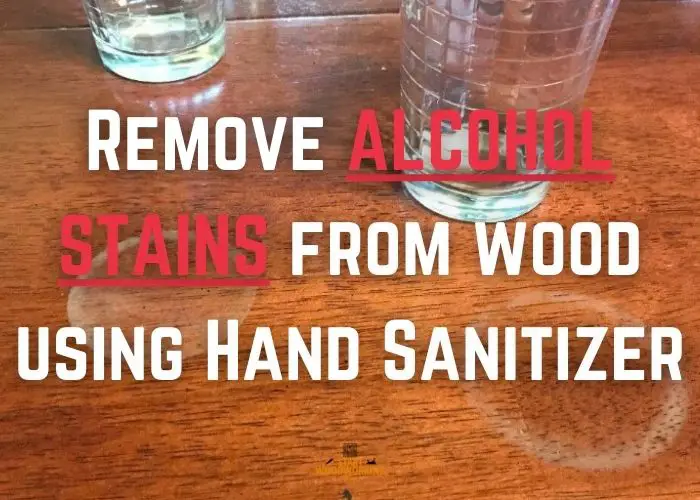
What You’ll Need:
- Hand sanitizer containing alcohol
- Clean cloths
- Toothbrush
Step 1: Prepare the work area
First, I make sure the surface of the stained wood is cleared of any objects, décor, or debris. This gives me ample working room to treat the stain. I have a spray bottle of water handy to rinse the surface when needed.
Choose a hand sanitizer that contains a high amount of alcohol, at least 60% or higher. The alcohol in the sanitizer will help break down and dissolve the alcohol in the stain. I prefer to use pure liquid sanitizers rather than gels for better penetration.
Step 2: Apply hand sanitizer
Next, I squeeze a quarter-sized amount of gel hand sanitizer directly onto the alcohol stain. Using my fingers or an old toothbrush, I gently spread and rub the sanitizer thoroughly over the entire stain.
You can also apply the hand sanitizer directly onto the stained area using a clean cloth or paper towel. Make sure to completely saturate the stain using plenty of sanitizer.
Step 3: Let it soak
Let the sanitizer sit for 5-10 minutes. This allows time for the alcohol to fully penetrate and loosen the stain. Set a timer so you don’t forget and let it work too long.
Step 4: Wipe and scrub
Use an old toothbrush and gently scrub the area in circles, following the direction of the wood grain. Apply light pressure to work the sanitizer into the stain without damaging the wood. The bristles will help agitate the stain from the pores.
Wipe away all of the hand sanitizer residue thoroughly with a clean dry cloth. Inspect to see if the stain has lightened or lifted. Repeat steps 2-4 if needed for stubborn stains.
Step 5: Rinse the wood surface
Once I am satisfied the stain is removed, I take a slightly damp cloth and give the area a final wipe down. This ensures any remaining sanitizer film is removed, preventing later streaking.
When most of the stain appears gone, I carefully rinse the wood with clean water from the spray bottle to remove any sticky sanitizer residue. I pat dry with a fresh towel.
Step 6: Dry completely
Allow the wood to fully dry before proceeding. Once dry, I apply a wood polish or conditioner to restore sheen and moisture to the wood. This helps blend any light remnants of stain.
Step 7: As a final protective measure, I apply a matte wood sealant. This prevents future alcohol stains from setting into the porous wood surface.
Method 3: Using Coconut Oil
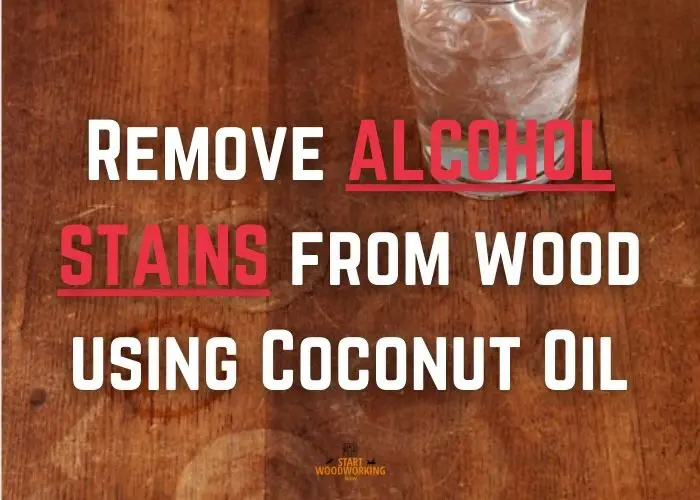
What You’ll Need:
- Coconut oil
- Cotton balls or soft cloth
- Clean rags or paper towels
- Toothbrush (optional)
- Beeswax paste wax
Step 1: Prepare the wood surface
First, I make sure the wood surface is clear of any objects or debris that could get in the way. I have clean rags or paper towels handy to wipe up the oil.
Step 2: Apply coconut oil
I pour a small amount of extra virgin coconut oil directly onto the alcohol stain. Using a cotton ball or soft cloth, I gently rub the oil over the entire stain, working it into the wood grain.
Step 3: Let it penetrate
I let the coconut oil sit and soak into the stain for 2-3 minutes. This allows the oil time to break down and dissolve the alcohol residue. I may apply a bit more oil to keep the area saturated.
Step 4: Wipe and scrub
Next, I lightly scrub the oiled stain with a clean cloth, using small circular motions. I wipe away any excess oil until the wood is dry and wipe my cloth as needed. This helps lift the stain from the wood.
Step 5: Repeat the process
If any stain remains, I repeat the application process 1-2 more times to fully penetrate and lift the alcohol stain. The coconut oil will continue to dissolve the stain with each application.
Step 6: Re-oil the wood surface
Once the alcohol stain is removed, I apply a thin coat of coconut oil over the entire wood surface to recondition it. Then I buff it dry with a fresh cloth for an even finish.
Step 7: As a final protective step, I apply a thin layer of beeswax paste wax. This seals the wood surface and makes it more resistant to future alcohol stains.
Method 4: Using Steel Wool and Wax
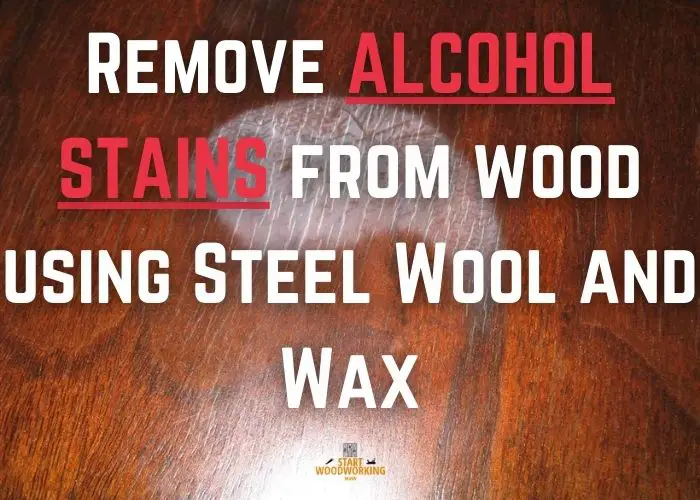
What You’ll Need:
- Steel wool – Super fine 000 or 0000 grade steel wool works best to lightly abrade the wood without scratching it.
- Paste wax – A soft paste wax formulated for wood furniture helps lift and draw out the alcohol stain. Avoid hard waxes.
- Clean rags – Cotton rags or microfiber cloths are ideal for applying the wax and wiping away any residue.
Step 1: Prepare the surface
First, I make sure the wood surface is cleared of any objects or décor that could get in the way. I have clean rags ready to wipe up any wax residue.
Step 2: Lightly sand the stain
Using extra-fine 000 or 0000 grade steel wool, I gently rub over the alcohol stain to lightly sand and break up the discolored wood fibers. I sand just enough to roughen the surface.
Step 3: Apply paste wax
Next, I rub a small amount of paste wax directly onto the sanded stain using a clean, soft cloth. I apply a thin, even coat over the entire stained area.
Step 4: Scrub with steel wool
Once the wax is applied, I use the steel wool to lightly scrub the waxed stain in circular motions. This helps lift the alcohol residue from the roughened wood pores. I wipe the steel wool clean as I go.
Step 5: Wipe away wax
With a clean rag, I carefully wipe away any wax residue left on the surface. I buff lightly until the wood looks clean and feels smooth.
Step 6: Repeat as needed
For deep set stains, I may do several rounds of sanding, waxing, and scrubbing until the alcohol stain is completely removed.
Step 7: Recondition the finish
Finally, I apply a fresh coat of paste wax to the entire surface to restore sheen and protection to the wood finish. Then I buff it to an even luster.
If you need to remove oil based stains from wood this is the best step by step guide you can find!
Method 5: Using Furniture Oil
Step 1: Assess the Stain and Wood Type
Begin by examining the alcohol stain to determine the type of wood and finish. Different woods and finishes may react differently to treatments. If possible, test a small, inconspicuous area to ensure the furniture oil won’t cause any damage.
Step 2: Gather Materials
Collect the necessary materials, including a clean, soft cloth, furniture oil suitable for your wood type, and possibly fine steel wool for stubborn stains. Ensure you are working in a well-ventilated area, and consider wearing gloves to protect your hands.
Step 3: Blot the Stain
If the alcohol spill is fresh, use a clean cloth to blot the excess liquid gently. Avoid rubbing, as this can spread the stain. Act quickly to prevent the alcohol from penetrating the wood surface.
Step 4: Apply Furniture Oil
I pour a small amount of furniture oil or tung oil directly onto the alcohol stain. Using a clean, lint-free cloth, I gently rub the oil over the entire stain, working it deeply into the wood grain. Furniture oils can often penetrate the wood, nourishing and revitalizing it while lifting the stain.
Step 5: Work the Oil into the Stain
Use a circular motion to work the furniture oil into the alcohol stain. This helps to break down and lift the stain from the wood fibers. Pay attention to the stained area, but also work the oil into the surrounding wood to maintain a consistent appearance.
I let the furniture oil sit for 2-3 minutes. This gives it time to penetrate and start breaking down the alcohol residue. I may reapply a thin layer of oil to keep it saturated.
Step 6: Wipe Away Excess Oil
After working the oil into the wood, use a clean, dry cloth to wipe away any excess oil. Ensure that the stained area is evenly coated, and the surrounding wood is free from oil residue.
Next, I lightly scrub the oiled stain using circular motions with a microfiber cloth. I continue wiping until the excess oil is removed and the wood feels dry. I replace my cloth as needed while scrubbing.
Once most of the stain is lifted, I carefully wipe the surface with a damp cloth to remove any excess oil residue. I pat dry with a fresh towel.
Step 7: Repeat if Necessary
For persistent stains, repeat the process. Furniture oil is generally safe to use multiple times, but it’s essential to follow the product’s instructions and not overapply.
Step 8: Finishing Touches
Once the stain is removed, consider applying a thin layer of furniture wax or polish to protect and enhance the wood’s finish. Buff the surface gently to bring out the wood’s natural luster.
Tips for Preventing Alcohol Stains on Wood
- Use coasters under glasses to prevent condensation rings. Choose quality cork or felt coasters that absorb moisture.
- Apply a protective finish like polyurethane to create a moisture barrier on wood. Reapply as needed over time.
- Immediately wipe up any spills of alcohol on the wood using a dry cloth. Don’t let excess liquid soak in.
- Place tablecloths or placemats on dining tables to prevent direct contact with wood. Use vinyl or cloth options that repel moisture.
- Avoid placing hot dishes or pans directly on wood surfaces. Use trivets or hot pads to prevent heat damage.
- For bars and counters, install a durable waterproof finish like epoxy resin on top. This prevents moisture penetration.
- Use furniture covers when wood furniture won’t be used for a while. This limits dust buildup and accidental spills.
- Increase airflow around wood furniture to allow moisture to properly evaporate. Avoid trapping moisture.
- Sand the wood surface lightly and re-oil periodically to maintain the protective oils in the wood grain.
FAQs
Some of the most effective products for removing alcohol stains from wood surfaces are baking soda, coconut oil, hand sanitizer, furniture oil, toothpaste, and oxalic acid.
Yes, the finish on the wood affects how deeply a stain penetrates and how easily it can be removed. Sealed finishes like polyurethane protect the wood more than oil or wax finishes. Alcohol stains on sealed finishes are easier to remove.
It is important to test any home remedy on an inconspicuous area of the wood surface to ensure that it does not cause damage or discoloration. Additionally, it is advisable to avoid using excessive water when treating alcohol stains, as wood does not react well to prolonged exposure to moisture.

